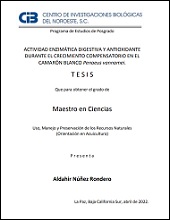| dc.contributor.advisor | Peña Rodríguez, Alberto | |
| dc.contributor.advisor | GUZMAN VILLANUEVA, LAURA TERESA | |
| dc.contributor.author | Núñez Rondero, Aldahir | |
| dc.date.issued | 2022 | |
| dc.identifier | https://cibnor.repositorioinstitucional.mx/jspui/handle/1001/2653 | |
| dc.identifier.uri | http://dspace.cibnor.mx:8080/handle/123456789/3118 | |
| dc.description.abstract | "En México, la acuicultura del camarón Penaeus vannamei es de gran importancia debido a su alto valor y demanda comercial. El alimento balanceado representa uno de los costos más significativos del cultivo, por lo que actualmente se exploran estrategias de restricción alimenticia temporal que pueden inducir un crecimiento compensatorio. Este último se refiere a la capacidad de los organismos de recuperar el peso corporal cuando las condiciones óptimas de alimentación son restauradas. Por otra parte, el conocimiento sobre los cambios a nivel fisiológico como la actividad enzimática digestiva y antioxidante durante el crecimiento compensatorio del camarón es limitado. Por ello, se realizó un bioensayo con una duración de 46 días, bajo los siguientes regímenes alimenticios: grupo control (alimentado a saciedad), y tres tratamientos de restricción alimenticia cíclica durante 18 días: a) 2 días a saciedad y 4 días de restricción del 50% (T2:4), b) 3 días a saciedad y 3 días de restricción del 66% (T3:3) y c) 4 días a saciedad y 2 de ayuno (T4:2), y posteriormente un periodo de recuperación de 28 días de alimentación a saciedad. De acuerdo al rendimiento productivo, los camarones registraron un crecimiento compensatorio completo en los tratamientos T2:4 y T3:3, al no presentar diferencias significativas en el peso promedio final respecto al control, obteniendo una reducción del alimento de hasta 11.6%. En el caso de la actividad enzimática digestiva, se observó un aumento significativo de amilasa para el tratamiento T3:3 y de lipasa para T2:4 al termino de los ciclos de restricción alimenticia. Durante el crecimiento compensatorio (día 32), se presentó un aumento significativo de quimotripsina para el tratamiento T4:2, y de lipasa para el T3:3. Al término del experimento (día 46), la actividad amilasa disminuyó para los tratamientos con restricción en comparación con el control. La actividad de catalasa mostró un incremento significativo en el tratamiento T3:3 al término de los ciclos de restricción (día 18), en el tratamiento T2:4 durante el periodo de compensación (día 32), y en los tratamientos T3:3 y T2:4 al término del periodo experimental (día 46), todos respecto al control. De acuerdo a los resultados encontrados, la capacidad de respuesta compensatoria en el camarón P. vannamei está estrechamente relacionada con la severidad y duración de los periodos de restricción..." | es |
| dc.format | pdf | es |
| dc.language.iso | spa | es |
| dc.publisher | Centro de Investigaciones Biológicas del Noroeste, S.C. | es |
| dc.rights | Acceso abierto | es |
| dc.subject | Penaeus vannamei, Crecimiento compensatorio, Actividad enzimática digestiva, Actividad enzimática antioxidante | es |
| dc.subject | Penaeus vannamei, compensatory growth, digestive enzymatic activity. Antioxidant enzymatic activity | es |
| dc.subject.classification | ENZIMOLOGIA | es |
| dc.title | ACTIVIDAD ENZIMÁTICA DIGESTIVA Y ANTIOXIDANTE DURANTE EL CRECIMIENTO COMPENSATORIO EN EL CAMARÓN BLANCO Penaeus vannamei | es |
| dc.type | masterThesis | es |
| dc.dirtesis.grado | Maestría en Ciencias en el Uso, Manejo y Preservación de los Recursos Naturales | es |
| dc.dirtesis.disciplina | Acuicultura | es |
| dc.dirtesis.universidad | Centro de Investigaciones Biológicas del Noroeste, S.C. | es |
| dc.dirtesis.facultad | Posgrado en Recursos Naturales | es |
| dc.description.abstracten | "In Mexico, the aquaculture of Penaeus vannamei is very important due to the high value and commercial demand. Balanced feed represents one of the highest costs in this industry, therefore temporary food restriction strategies are explored to induce compensatory growth. The latter refers to the ability of organisms to regain body weight when optimal feeding conditions are restored. On the other hand, the knowledge about the changes at a physiological level such as the digestive and antioxidant enzymes activities during the compensatory growth of shrimp is limited. For these reason, a bioassay was carried out with a duration of 46 days, under the following dietary regimens: control group (fed to satiety), and three treatments of cyclical feeding restriction for 18 days: a) 2 days of feeding to satiety and 4 days with feed restriction at 50% (T2:4), b) 3 days of feeding to satiety and 3 days with feed restriction at 66% (T3:3), and c) 4 days of feeding to satiety and 2 days of fast (T4:2), later a recovery period of 28 days of feeding to satiety. According to the productive performance, the shrimp registered a complete compensatory growth in treatment T2:4 and T3:3, as they did not present significant differences in the final average weight compared to control, obtaining a food reduction of up to 11.6%. In the case of digestive enzyme activity, a significant increase in amylase was observed for the T3:3 treatment and lipase for T2:4 at the end of the cycles of food restriction. During compensatory growth (day 32), there was a significant increase in chymotrypsin for the T4:2 treatment, and in lipase for the T3:3. At the end of the experiment (day 46), amylase activity decreased for the treatments with restriction compared to the control. Catalase activity showed a significant increase in treatment T3:3 at the end of the restriction cycles (day 18), in treatment T2:4 during the compensatory growth (day 32), and in treatments T3:3 and T2:4 a t the end of the experimental period (day 46), all compared to control treatment. The results showed that the compensatory response in P. vannamei shrimp, is closely related to the severity and duration of the restriction periods. The feeding restriction regime promotes changes in the digestive and antioxidant activities, which could be used as indicators to predict the good management practices of feed restriction, in order to diminish the cost of shrimp production." | es |

